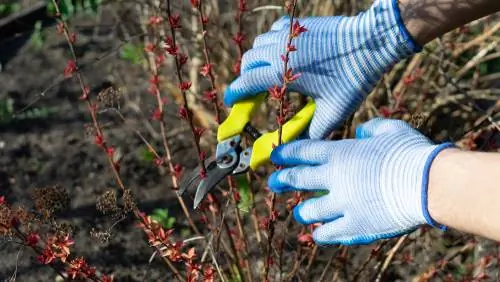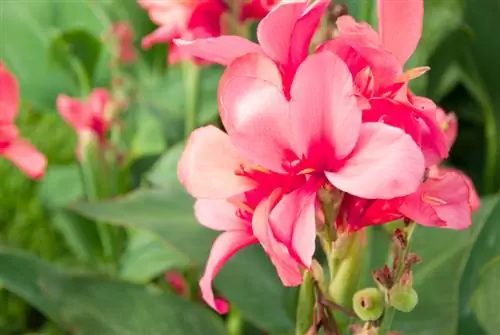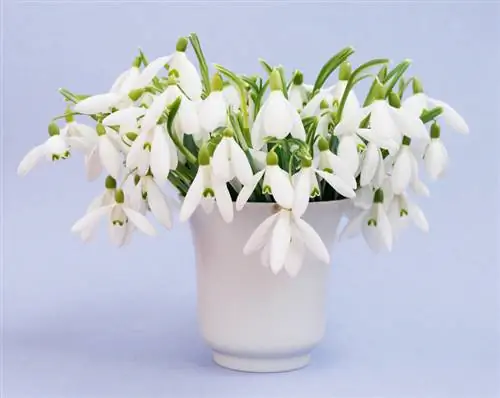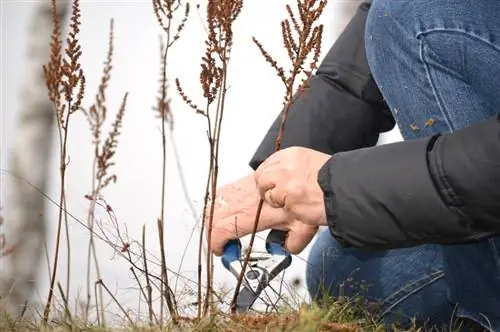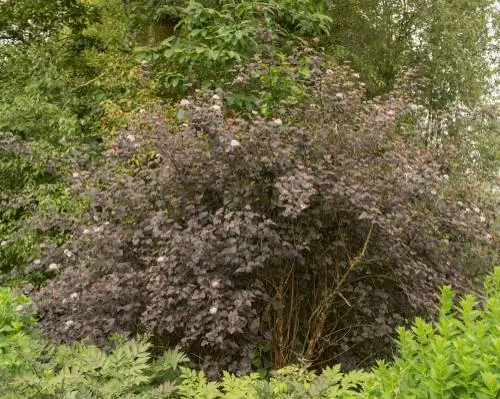- Author admin [email protected].
- Public 2023-12-16 16:46.
- Last modified 2025-01-23 11:21.
The variety-specific flowering time plays a key role in pruning spars. The timing and method of cutting depend on whether it is a spring or summer flowering spar bush. These instructions explain the connections so that you can cut Spiraea correctly.
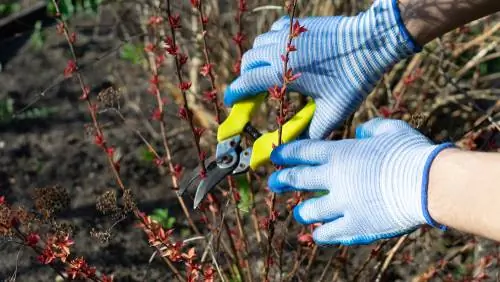
When and how should you cut spars?
Cut back summer-flowering spars heavily in spring, ideally to 10 to 20 cm. Spring-flowering spars require a thinning cut every 2 years after flowering, in which a third of the oldest shoots are removed at ground level.
Cut summer bloomers in spring
In the summer garden, the Japanese spirea (Spiraea japonica) and the red summer spirea (Spiraea bumalda) display their furious blossoms. The buds for the floral spectacle are placed on this year's shoots. With this habit, the flowering bushes make life easy for the gardener. A vigorous pruning in early spring sets the stage for lush flowering from summer to autumn. How to cut correctly:
- Best time is from the end of January to the end of February
- Recommended cutting tool: Garden or pruning shears with bypass mechanism
- Ideally cut back all shoots to 10 to 20 cm
- Optionally blend a little more moderately by a third
This cut is typical for many well-known summer-flowering shrubs, such as butterfly lilac. The task of vigorous pruning is to create space for the young wood, because this is where the most beautiful flowers develop.
Thimout spring bloomers every 2 years
In April and May, early blooming spars transform the bed and balcony into a picturesque sea of flowers. Premium varieties are the bridal spirea (Spiraea arguta), the magnificent spirea (Spiraea vanhouttei) and the ash-gray spirea (Spiraea cinerea). The spring beauties lay their buds on the shoots of the previous year. This circumstance prohibits vigorous pruning, as is advisable for summer-flowering varieties. You can promote flowering and vitality with thinning cuts at 2-year intervals. How to do it right:
- The best time is after the end of the flowering period
- Cut off a third of the oldest scaffold shoots at ground level
- Cut back this year's growth on overly long branches
- Cut a few millimeters above an alternate pair of leaves
By cleaning out wilted inflorescences, a spar bush may be stimulated to rebloom slightly. Place the scissor blades 3 to 4 millimeters above a pair of leaves or a bud.
Perform rejuvenation pruning in winter
Without the occasional thinning cut, your spar bush will lose its flowering potential because a dense network of shoots will shade each other. The problem can be solved with a radical rejuvenation cut. During the leafless winter period, cut back all shoots to knee height. Remove dead wood at ground level. To protect our threatened birdlife, the Federal Nature Conservation Act allows rejuvenation measures on trees between October 1st and February 28th.
Tip
Although its name suggests the opposite, the bladder spar does not belong to the genus Spiraea, but is assigned to the genus Physocarpus. The deciduous deciduous shrub, also known as pheasant spar, grows up to 4 meters high and blooms in June and July. As a summer bloomer, the time window for shape and thinning pruning opens in late winter. In contrast to summer-flowering spar shrub varieties, the flowering tree benefits from less vigorous pruning by a third or half.

